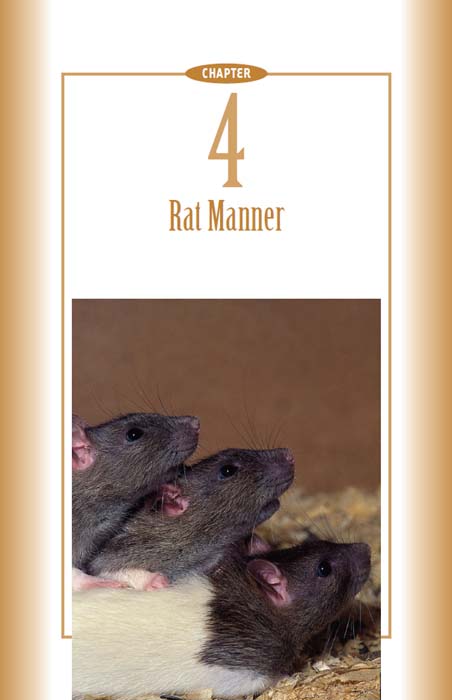

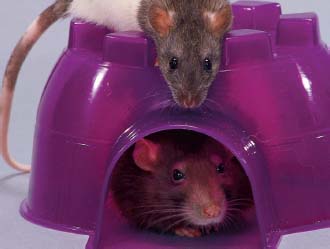
To train your rats, you first need to learn all about them. For instance, rats feel secure in small, tight places.
UNDERSTANDING THE NATURE, TYPICAL BEHAVIORS, and likes and dislikes of rats is essential if you wish to properly care for and train them. First and foremost, you need to know about their social organization.
One reason why rats are particularly good research-study subjects is that their social organization is similar to the social organization of humans. Rats form family and community (colony) groups with a clear social order. Each colony has a governor; each “household,” a family director. In general, rat society functions smoothly as long as no individual tries to change his position in the social hierarchy. When individuals challenge the director, scuffles and fights break out that tend to upset the entire colony.
One research study involving rats tested the relationship between overpopulation and aggression. The more crowded the environment, the more aggressive the rats became. So if you plan to have a rat colony of more than two individuals, make certain that the cage can house its residents without overcrowding. In addition, make sure that all residents are introduced on neutral territory (see chapter 2). Rats can become angry enough to inflict horrific, even fatal, wounds on one another.
Learning to live harmoniously has much to do with education. The higher the education, the easier it will be to get along. The more you stimulate Ben and Ira, the happier they will be and the better they will behave toward each other. Each rat needs equal attention. Take the time to work with both (or all three, four, or more) daily.
Rats are by nature nocturnal creatures. Left to themselves, they will perform all of their antics at night. So if you have a squeaky wheel in their enclosure, either take it out prior to bedtime or place their cage in a soundproof room. You can be certain that the wheel will be turning, and squeaking, a good part of the night. That’s not likely to strengthen the bond between you and your rat.
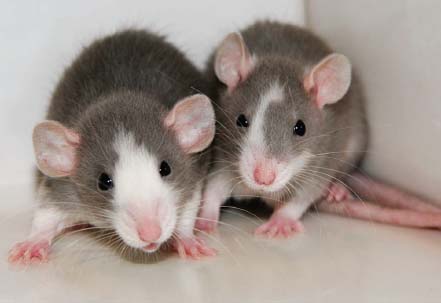
Two cozy rats from the same colony present a united front to observers. Rats are social creatures, with many of the same traits as humans.
When you begin training, you will be changing Ben and Ira’s nocturnal schedule quite a bit, as they’ll be receiving all sorts of activity and food during the day. You may soon have a good night’s sleep. As rats are very adaptable to their surroundings, your little guys will quickly learn to adjust to your schedule.
Rats love to groom themselves and one another. It’s a form of socializing—compare it to girls’ doing one another’s hair and nails at a slumber party. As rats prefer to be clean, they will spend lots of time licking one another and nibbling off dry flakes of skin. On occasion, you can observe one rat holding down another to be groomed. This actually has two purposes: to hold the groomee still and to tell that groomee that the groomer is the boss. It’s a means of expressing dominance.
Petting your rat is in effect grooming him. Many rats will hold their heads down as they are being groomed. However, they won’t maintain this posture for long, as they would much rather explore than remain in one spot.
Your rat will invite grooming by lying still with his head down. Some rats enjoy your touch and the grooming process so much that their eyes will appear to bulge in and out, and you might hear their teeth grinding. “Oh, that’s nice,” says Ben. “Just a little behind the ears,” says Ira. Should your rat roll onto his back for a tummy rub, you’re a real rat charmer!
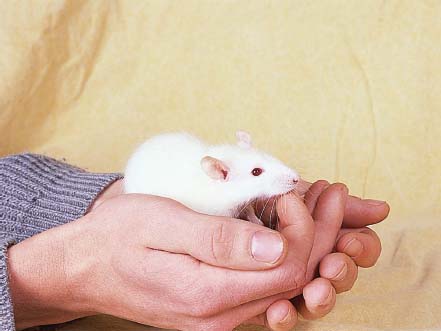
Rats will sometimes groom their owners—take it as a compliment!
Many rats bond with their people enough to groom them, too. The animals will lick and sometimes nibble a bit to take off skin flakes. While this habit might be a little scary at first, it rarely hurts, as the nibbles are very shallow, more like tickles. If Ira does get a little carried away with those nibbles, squeak and pull away. Ira will understand that the grooming became too serious and back off a bit.
It is indeed rare for a domesticated rat to bite without reason. Fancy rat varieties really aren’t aggressive animals. Contrary to historical popular opinion, rats prefer to be social and affectionate. If you are bitten by your rat, there is a reason. Identify the reason and learn what to do, and what not to do, to avoid repeating the incident.
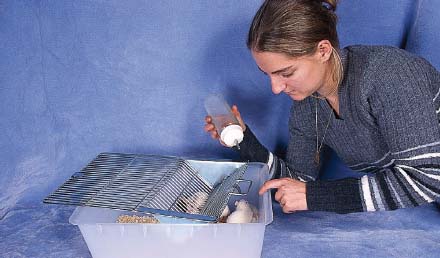
Warn other people not to poke their fingers in your rats’ cage—unless they want those fingers bitten.
Rats will bite when frightened, startled, or in pain or to protect their territory. Many rats can be wary of strangers, especially if they haven’t been properly socialized as pups. If a stranger reaches into the cage or pokes a finger through the bars, there is a good chance he or she will be bitten. Rats also bite at their food; if you give Ben food every time you visit with him, he’ll learn to associate your extended hand with food and bite at your fingers, expecting food to be there.
The more you handle Ben and Ira, the more acclimated they’ll be to you and others. Try to spend at least a half hour to an hour per day training, playing with, and cuddling Ben and Ira. Rats enjoy this interaction, even if they do have the company of other rats.
Rats, especially females, instinctively move around. They are very curious and love to search out dark places. Their keen sense of smell is also a driving factor, and they can locate tiny particles of food at great distances. Their long whiskers help them move around in small, dark places, because they translate the terrain as the animals move through it, much as the whiskers on felines, who also tend to be nocturnal, do.
Bite Prevention

Use soap and water before and after handling your rat.
HERE ARE A FEW SUGGESTIONS TO KEEP YOURSELF AND OTHERS FROM BEING BITTEN:
1. When you play with your rat, make sure that you first wash your hands thoroughly so that there is no scent of food on your fingers. This is also a sensible practice if you are handling several different rat colonies within a short time period, as you can pass a bacterial infection from one colony to another.
2. Never tease Ben and Ira. If feeding by hand, hold the food still. Otherwise, as they try to reach for the food, they’ll become frustrated and use their teeth instead of their paws.
3. Never startle your rats by grabbing them. Always give them a chance to crawl onto your hand to be lifted for playtime, training, or cuddling.
4. Use consistent signals at all times. When you are ready to begin a training session, tap the surface with your target stick (see chapter 5). When you wish to offer playtime, either insert a ladder into the play area or hold your hand flat on the surface and allow Ben and Ira to climb aboard.
5. If Irma has babies, let her decide whether she wants to socialize with you or not. Some mommy rats become very protective of their babies. It would be best to place a ladder into the play area in the cage and allow Irma to come out if she wishes. When she comes out, then you can offer your hand for social time.
6. Make sure that visitors to your home do not stick their fingers or food through cage openings. This is both frightening and frustrating for rats as they try to take food from unfamiliar hands and find that their paws can’t quite reach it. Chances are they’ll try using teeth.
7. Allow new or frightened rats an adjustment period. Don’t forget that a frightened rat will bite. This can take anywhere from a few hours to a couple of days. You’ll know when your rat is moving around, curious, instead of trying to hide in dark places. A curious rat is content. Time to play.
8. If your rat is injured and you must handle him in order to treat or transport him, wrap the rat in a towel. Not only will this insulate you from feeling his teeth, but it will also offer more security for your rat, reducing the chance that you’ll be bitten.
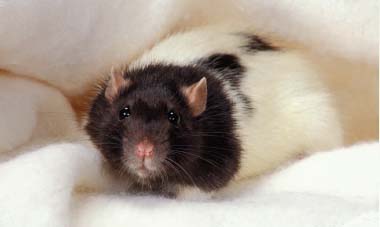
Let your rat adjust to his surroundings before handling; he will feel less over-whelmed and threatened.
A rat will seek some sort of solid vertical surface along which to move. Hence, you’ll see your rats run along a wall or the sides of furniture as they explore. This gives the rodent a sense of stability as well as added security, since they can’t be attacked from all sides.
Rats chew. There’s no getting away from it. It’s what they do. It’s how they spend their time. It’s how they build their nests. It’s how they play. If a substance isn’t made of metal, a rat can chew it.
When you have your rat out and about, you’ll need to keep a close eye on what objects go into his mouth. Everything is fair game, from your clothing to the couch you sit on. It’s best to prepare the rat’s play area prior to allowing him free rein, and it’s up to you to provide safe chew toys. Place an old sheet or clothing over surfaces you want to protect so that you won’t be upset when it is riddled with holes. Better the old sheet than the expensive couch cushions.
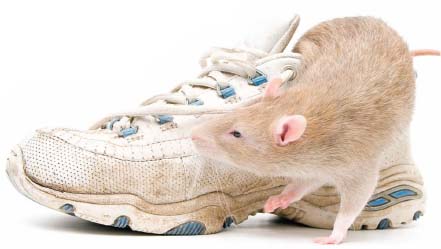
If you let your rat out of his cage, you may wish to hide any chewables you don’t want damaged.
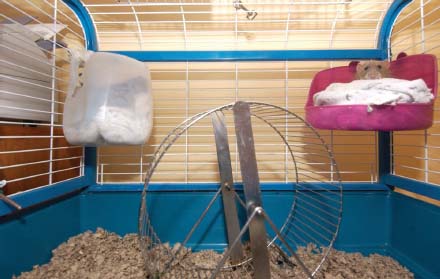
Make sure that every item in your rat’s cage will survive his chewing and tearing.
Paper is a favorite rat toy. Rats will spend hours shredding and packing the pieces into bedding. You must be certain that all paper within reach of Ben and Ira is clear of potentially toxic substances such as inks.
Plastic will also fall victim to Ben and Ira’s chewing frenzies. Never use plastic in their cages. Any dishes, cage clips, water bottles, or trays made of it will be destroyed sooner or later. You’ll be far better off using stainless steel dishes in a metal cage with metal housings. Your rats will put their teeth on the metal but not be able to chew it to pieces.
As you want to stimulate your rats by putting toys, ladders, and ropes in their cage, you must accept the fact that these will need to be replaced every so often. Ditto for sleeping hammocks. Rats love sleeping hammocks, but some will chew the straps that keep the hammocks anchored to the top of the cage.
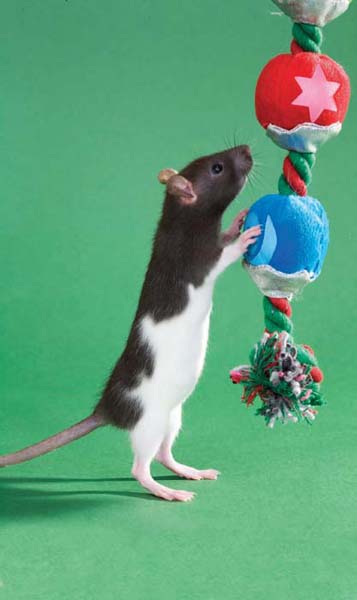
Ropes are great for climbing but are not safe for chewing—supervise carefully.
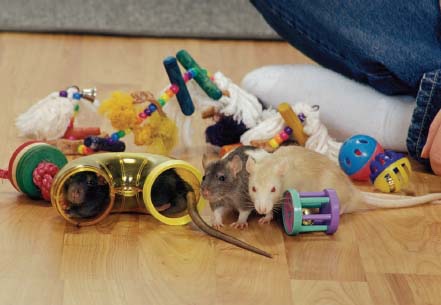
If you feel your pet shop’s rodent aisle is lacking, check out the bird toys!
Many kinds of safe rat chew toys are available in pet shops and online. You can also select chew toys from the many colorful toys sold for exotic birds. The great thing about bird cage toys is they can hang from the top of a cage, giving your rat something to climb on as well as a safe chew toy.
Dog chew toys are another possibility. Not only are these healthy chew toys, but they also help keep Ben and Ira’s teeth ground to healthy lengths. Nylabones, Booda Velvets, Gourmet Health Chews, and even regular dog biscuits are good choices. The rope toys can be suspended from different areas of the cage, offering a virtual jungle gym for Ben and Ira. The options for their home and playground are enormous. Let your imagination take you on a rat adventure!